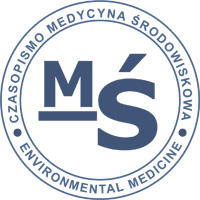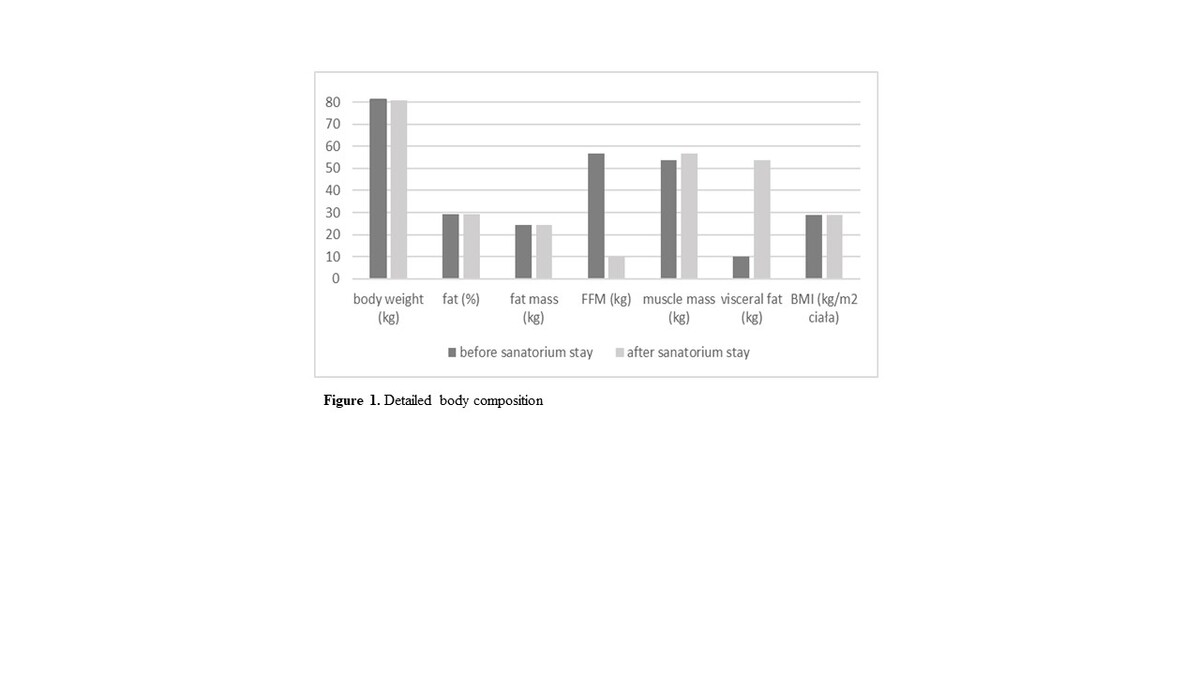RESEARCH PAPER
Effect of sanatorium treatment on increasing phase angle values
1
Institute of Medicine, Jan Grodek State University, Sanok, Poland
2
Institute of Medicine, Jan Grodek State University in Sanok, Polska
3
Department of Toxicology, Toxicological Analysis and Bioanalysis, Medical University of Silesia, Katowice, Poland
Corresponding author
Med Srod. 2025;28(3):98-102
KEYWORDS
TOPICS
ABSTRACT
Introduction and objective:
The phase angle is considered an indicator of the integrity and function of cell membranes and the overall nutritional status of the body. Phase angle measurement can be an indicator to improve performance and recovery in athletes. It also informs about hydration of the body, occurrence of swelling, and monitoring the level of fluids in the body. The aim of the article is to determine the impact of a 21-day sanatorium stay on the tissue condition of the participants by analyzing the phase angle values.
Material and methods:
The study included 261 patients aged 39–89 years undergoing a sanatorium stay at the ‘Solinka’ Sanatorium in Polańczyk in the Subcarpathian Province, south-east Poland. Phase angle measurements were taken at the beginning and end of the stay using the Tanita MC-780 MA-N multi-frequency bio-electrical impedance analyzer.
Results:
The results of the study show that the 21-day sanatorium stay had a significant impact on improving the tissue condition of the participants, as reflected in changes in phase angle values. Before the stay, the average phase angle was 5.53°, while after the stay, it increased to 5.69°, F K-W=184.006. This change is statistically significant, suggesting that the sanatorium treatment brought measurable health benefits. The greatest increase in this parameter was observed in individuals who participated in pool exercises and balneotherapy, highlighting the role of these treatments in improving physical condition.
Conclusions:
The 21-day sanatorium stay had a positive effect on cellular health, as reflected in the increase in phase angle values. Physiotherapy treatments, such as pool exercises, balneotherapy and mud wraps, are particularly effective in improving tissue condition.
The phase angle is considered an indicator of the integrity and function of cell membranes and the overall nutritional status of the body. Phase angle measurement can be an indicator to improve performance and recovery in athletes. It also informs about hydration of the body, occurrence of swelling, and monitoring the level of fluids in the body. The aim of the article is to determine the impact of a 21-day sanatorium stay on the tissue condition of the participants by analyzing the phase angle values.
Material and methods:
The study included 261 patients aged 39–89 years undergoing a sanatorium stay at the ‘Solinka’ Sanatorium in Polańczyk in the Subcarpathian Province, south-east Poland. Phase angle measurements were taken at the beginning and end of the stay using the Tanita MC-780 MA-N multi-frequency bio-electrical impedance analyzer.
Results:
The results of the study show that the 21-day sanatorium stay had a significant impact on improving the tissue condition of the participants, as reflected in changes in phase angle values. Before the stay, the average phase angle was 5.53°, while after the stay, it increased to 5.69°, F K-W=184.006. This change is statistically significant, suggesting that the sanatorium treatment brought measurable health benefits. The greatest increase in this parameter was observed in individuals who participated in pool exercises and balneotherapy, highlighting the role of these treatments in improving physical condition.
Conclusions:
The 21-day sanatorium stay had a positive effect on cellular health, as reflected in the increase in phase angle values. Physiotherapy treatments, such as pool exercises, balneotherapy and mud wraps, are particularly effective in improving tissue condition.
REFERENCES (25)
1.
Baş D, Atahan C, Tezcanli E. An analysis of phase angle and standard phase angle cut-off values and their association with survival in head and neck cancer patients undergoing radiotherapy. Clin Nutr. 2023;42:1445–1453.
2.
Lewitt A, Mądro E, Krupienicz A. Podstawy teoretyczne i zastosowania analizy impedancji bioelektrycznej (BIA). Endokrynologia, Otyłość i Zaburzenia Przemiany Materii. 2007;2:79–84.
3.
Małecka-Massalska T, Popiołek J, Teter M, et al. Wykorzystanie kąta fazowego do oceny stanu odżywienia pacjentów z jadłowstrętem psychicznym. Psychiatr Pol. 2017;51:1121–1131.
4.
Asano Y, Nagata K, Shibuya K, et al. Association of 24-h movement behaviors with phase angle in community-dwelling older adults: a compositional data analysis. Aging Clin Exp Res. 2023;35:14691476.
5.
Martins PC, Junior CASA, Silva AM, et al. Phase angle and body composition: A scoping review. Clin Nutr ESPEN. 2023;56:237–250.
6.
Fu L, Ren Z, Liu X, et al. Reference data of phase angle using bioelectrical impedance analysis in overweight and obese Chinese. Front Endocrinol. 2022;13:924199.
7.
da Silva BR, Orsso CE, Gonzalez MC, et al. Phase angle and cellular health: inflammation and oxidative damage. Rev Endocr Metab Disord. 2023;24:543–562. doi:10.1007/s11154-022-09775-0.
8.
Kochański J. Historia polskiej balneologii w zarysie. In: Ponikowska WI, Kochański J. Wielka księga balneologii, medycyny fizykalnej i uzdrowiskowej. Konstancin-Jeziorna: ALUNA; 2017. Tom I:33–46.
9.
Antonelli M, Donelli D. Effects of balneotherapy and spa therapy on levels of cortisol as a stress biomarker: a systematic review. Int J Biometeorol. 2018;62:913–924.
10.
Helbin J, Olarzyk EK. Natural environment advantages in pharmacological treatment support. Probl Hig Epidemiol. 2005;86:22–26.
11.
Kuryliszyn-Moskal A, Hryniewicz A, Dziura J. Balneotherapy in the treatment of rheumatoid arthritis and osteoarthritis. Forum Reumatol. 2017;3:168–172.
12.
González-Muniesa P, Mártinez-González MA, Hu FB, et al. Obesity. Nat Rev Dis Prim. 2017;3:17034.
13.
Harris KK, Zopey M, Friedman TC. Metabolic effects of smoking cessation. Nat Rev Endocrinol. 2016;12:299–308.
14.
Stodolny J. Choroba przeciążeniowa kręgosłupa. Epidemia naszych czasów. Kielce: ZL Natura; 2003.
16.
Dittmar M, Reber H, Kahaly GJ. Bioimpedance phase angle indicates catabolism in Type 2 diabetes. Diabet Med. 2015;32:1177–1185.
18.
Norman K, Herpich C, Müller-Werdan U. Role of phase angle in older adults with focus on the geriatric syndromes sarcopenia and frailty. Rev Endocr Metab Dis. 2023;24:429–437.
19.
Karagülle M, Kardeş S, Dişçi R, et al. Spa therapy for elderly: a retrospective study of 239 older patients with osteoarthritis. Int J Biometeorol. 2016;60:1481–1491.
20.
Martins AD, Brito JP, Batalha N, et al. Phase angle as a key marker of muscular and bone quality in community-dwelling independent older adults: A cross-sectional exploratory pilot study. Heliyon. 2023;9:e17593.
21.
Matsumoto Y, Tada M, Yamada Y, et al. Relationship between the phase angle from bioelectrical impedance analysis and daily physical activity in patients with rheumatoid arthritis. Mod Rheumatol. 2024;34:340–345.
22.
Silva AA, de Melo GF, de Almeida Filho EJB, et al. Correlation between phase angle and muscle mass, muscle function, and health perception in community-dwelling older women. Sport Sci Health. 2023;19:713–721.
23.
Asano Y, Tsuji T, Kim M, et al. Cross-sectional and longitudinal study of the relationship between phase angle and physical function in older adults. Geriat Gerontol Int. 2023;23:141–147.
24.
Górska S, Pijanowska M. Zastosowanie borowiny w rehabilitacji i odnowie biologicznej. Gerontologia Współczesna. 2014;4:176–179.
25.
Chojnowski J. Balneoterapia i fizykoterapia w leczeniu otyłości. In: Ponikowska I. Wielka Księga Balneologii, Medycyny Fizykalnej i Uzdrowiskowej. Konstancin-Jeziorna: ALUNA; 2018. Tom II, 268–281.
Share
RELATED ARTICLE
We process personal data collected when visiting the website. The function of obtaining information about users and their behavior is carried out by voluntarily entered information in forms and saving cookies in end devices. Data, including cookies, are used to provide services, improve the user experience and to analyze the traffic in accordance with the Privacy policy. Data are also collected and processed by Google Analytics tool (more).
You can change cookies settings in your browser. Restricted use of cookies in the browser configuration may affect some functionalities of the website.
You can change cookies settings in your browser. Restricted use of cookies in the browser configuration may affect some functionalities of the website.



